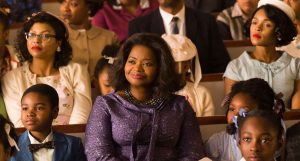Directed by Theodore Melfi | Written by Melfi and Allison Schroeder, adapting a book by Margot Lee Shetterly | 127 min
A few weeks ago I took in the Jeff Nichols drama Loving, the true story about the fight for civil rights and social justice in the ’60s in rural Virginia. It’s about an interracial couple who love each other despite the state laws against it. It felt authentic to the time and place, as well as a moving romance. While watching Hidden Figures, set at the same time just up the road in Langley, dealing with a similar struggle for rights and recognition, I couldn’t help but compare the films. Where Loving is rich and unexpected, Hidden Figures is artificial and formulaic. It tells an important story, but it does so by never stepping away from convention.
Katherine Goble (Taraji P. Henson) is a brilliant physicist and mathematician working at NASA with Dorothy Vaughan (Octavia Spencer) and Mary Jackson (Janelle Monáe) on efforts to put men into space before the Soviets. History records that the Russians beat them to it, but the Americans caught up quickly, many thanks to these women. It’s a contribution that’s important to acknowledge, but Melfi, director of St Vincent, never met a storytelling cliche he didn’t want to reach out and hug.
Each of these women have their own arc—one you can pretty much predict by watching the trailer—battling with a brutal combination of systemic racism and sexism in both public life and the workplace. Goble’s a widow, with three daughters at home being looked after by her mother, while being courted by a military man (Mahershala Ali). At work she’s promoted, dealing with the bad attitude of white coworkers (like a one-note Jim Parsons) and a gruff but fair, gum-chewing boss (Kevin Costner), who starts to recognize her brilliance. Vaughan is looking for the supervisor title to go with her responsibilities while butting heads with her superior (Kirsten Dunst), and Jackson is looking to upgrade her skills so she can work as an engineer at NASA, but needs to attend an all-white school in order to do it, which means taking her case to court. All of this is good to know from a historical perspective, and would have been more interesting as a documentary. Here the drama plods, with every emotional note signposted.
What makes any of it worth sitting through, aside from the historical importance of the story, is the cast. Henson, Spencer, and Monáe charm, carry the entire picture and squeeze whatever truth they can from its routines.
The film does one other thing that helps make it memorable: It suggests that America’s failure to beat Russia into space is causally connected to its slow progress to embrace civil rights, that the astonishing achievement of the NASA program—and thereby the highest ambitions of the entire country—only came when the people in charge allowed African-Americans to contribute. That’s an idea worth getting behind.








